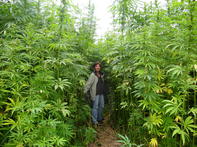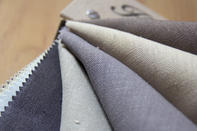Hemp (Cannabis sativa) is a type of cannabis with low levels of the euphoric THC cannabinoid and does not cause the ‘high’ associated with its cousin, the psychoactive ‘dagga’ (marijuana).

The long fibres of the outer part of the fast-growing hemp plant have been used for strong textiles such as jeans, shoes, ropes and sails. In fact, materials made from hemp have been discovered in tombs dating back to 8 000 B.C. and the explorer Christopher Columbus used hemp ropes on his ships rigged with hemp sails.
How to Process Hemp to Textiles
Hemp grown for fibre in the production of textiles needs to be harvested early during the flowering stage before the seed is produced. This can be 70 - 90 days after seeding. Harvesting of hemp is done with a conventional combine harvester machine.
The first step in processing hemp is retting. Retting is when hemp stalks are left to soak in water. Retting (or rotting) is when bacteria and fungi breakdown the pectins that hold the hemp fibres together.
Retting can be done in three ways. Hemp stalks can be left in the field for between four and six weeks, immersed in water for about 10 days or treated with enzymes. When the retting process is complete, the stalks will appear white with the long fibres separating easily from the woody core.
In the next step, the hemp stalks are collected and sent to the “decortication” machine. In this process, the stems are broken and the woody core separated from the long hemp fibres.
The long fibres are sent through a roller when the fibres are softened before being cut from 3m to shorter lengths for example 650mm. The shorter pieces are them combed, smoothed and any short, tangled or woody particles removed. The short fibres are known as ‘tow’ and the long fibres are called ‘line fibre’.
The hemp fibres are then aligned into a continuous “sliver” for spinning, either wet or dry. Wet spinning yields the best yarns as it softens the pectin allowing for a better separation of the fibres and producing a finer hemp yarn.
Advantages of Hemp Fibre

The advantages of growing hemp include that less water is needed to grow hemp and fewer pesticides are used as it is pest and disease-resistant while the yield of hemp fibre (per hectare) is high.
In terms of fibre quality; hemp is one of the strongest natural fibres, a good insulator, has excellent breathability, is resistant to mould and mildew and is highly resistant to wear-and-tear. The softness of hemp fabric increases with wear.
In terms of hemp as a textile for home furnishings, it has superior UV blocking properties (suitable for blinds and curtains) and does not stretch much so upholstered products retain their shape.
By Marinda Louw